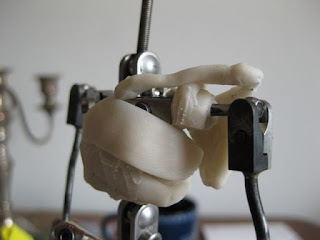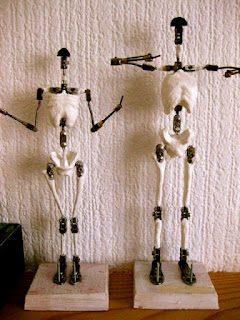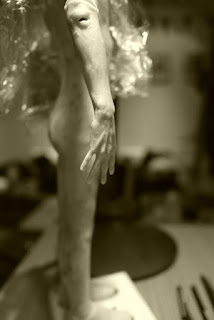Every artist's work has some element of the autobiographical. My stop-motion work is very much autobiographical, in many ways. Russeau, just like Rainer in Solo Duets, is fundamentally a self-portrait.
The evolution of a face.
The years between projects are not estranged from stop-motion. I am always thinking of new ideas, and everything in life feeds what I do. Early on I decided I wanted more realism than I had in Solo Duets. Anatomy is where this begins, and a functioning clavicle bone was one of the main elements I wanted my new puppets to adopt.
Russeau, as well as the other four characters in the film, were built mixing Andy Simmons armature parts with John Wright parts. I pulled apart my puppets from Solo Duets and reused as much as I could from them, and ordered some extra newer elements from Andy, and the smaller parts for arms, wrists, and ankles from John Wright.
Russeau's assembled mixed armature, with a wax "sketch" of a clavicle built onto the armature.
a first rough and quick mockup to understand the shapes in the upper chest

Tobias and I had never tried life casting with alginate. We thought it could be fun, and also a useful thing to have to look at whilst sculpting. We had dental alginate, which was very fast setting, and minty, so slightly uncomfortable to the eyes!
The most interesting thing about casting a version of your head is seeing the actual size of your face, and being able to hold it in your hands.
The weight of the alginate with gravity made parts of me droop, so it wasn't as accurate as I would have hoped, but it was useful.
Cardiff.
Here is a clear view of my clavicle design, and Tobias' ingenious way to fix one of the two 3mm balls in the wrist joint, to allow it to swivel but not bend. This created a two bone forearm much like human anatomy.
I started bulking a light skeleton with Staedtler's FIMO air Light. It was a mistake, as sculpting would show that I had bulked too much in some areas.
Russeau's beginnings, using Tiranti's White Modelling Wax
The hard skull I had made in the bulking stage was now a problem. It had to come out.
Removing the hard skull
I found that hair helped in seeing things. And that the mouth needed work.
Russeau and Madame Fontaine were ahead of the others.
Travel from Cardiff to Assisi, Italy.
comparison between Young Rainer (Solo Duets), and the new figures. Although we were theoretically working to the same scale back in 2005, the difference is substantial.
Liz, working on shirt designs.
Hair loss, something inevitable.
Fingers are a problem in stop-motion. At this scale one cannot fit armature parts, hence good bones and joints. Therefore fingers must be made with wire, which bends very differently to a hinge or ball and socket joint.
I started wondering whether creating deep notches in the palm and fingers would encourage the wire to bend where it found was less resistance from the silicone. I was not bothered by the aesthetics of these groves, and actually rather liked them. However, after modifying Russeau's hands, and Isolde's and Anna's to this design, I decided the idea was flawed. The main problem with wire is not where it bends, but how it bends. Though the groves might have encouraged the wire to bend where I wanted it to, they would not affect the rounded and wide bend in wire makes. Wire will not bend to tight angles, the way a hinge or finger will, hence there was nothing I could do. Even if I managed to create bones in the fingers, the wire would still unavoidably bend in an unnatural way. Hands were eventually reworked without the groves.
Donald's foot armatures were so beautiful that I could not bring myself to even contemplate touching them. He had made them to the scale I'd ask for, which was, of course too large. I later ground back Anna's and Isolde's, and will do so with Russeau as well.
Shoes are surprisingly difficult to sculpt. For some reason I had made boots, copying what I had, but then decided to cut down to shoes. Could have left one for each foot, rather interesting.
Traveling to London.
Russeau & Isolde
Hands must be removed from the body to be properly sculpted. By now I had also decided that they would be moulded and cast separately, rather than blocking off parts of a full mould in order to cast just the hands.
Russeau's and Anna's hands, packed and ready to travel to the Scottish Borders, for mould-making.
See the first two entries of March.
Her feet were clean...
Mould bed. See the second entry for March for details of the process.
Looking through a silicone skin
Silicone half mould, in case I made a mess of the rigid mould and destroyed the sculpture. Looks like a sea monster.
De-moulded. Somewhat H.R. Gigerish
Liz was unable to work on costumes without the figures. A priority of mine was to cast foam versions of the figures for her to use as costume mannequins, which could be stabbed with as many pins as she wished. Later I found myself simply re-casting them in silicone, so she had the possibility to somewhat control the shape of the body through fashion.














































































No comments:
Post a Comment